Parasites often prevent a person from living normally, because they greatly weaken the body. What representatives parasitize us most often, as well as how to deal with them, the article will tell.
Parasites are creatures that live and feed on their host. They can inhabit all animals, fish, birds and humans. This causes a lot of problems, because these creatures practically spoil health. Parasites in the human body can live in the liver, intestines, blood, and even attack the brain and lungs. What are the most common types? There are several different categories of parasites: flat and round worms, protozoa, and insects. How they affect the body and how to expel them, the article will tell.
Types of parasites
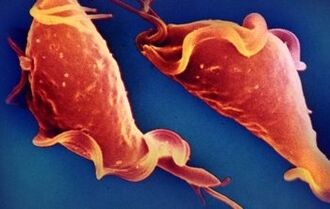
As already mentioned, there are different types of parasites in the human body:
- protozoa (trypanosome, plasmodium malaria, lamblia, amoeba dysentery);
- flatworms (feline parasites, liver parasites, bovine and porcine tapeworms);
- roundworms (pinworms, pinworms);
- insects (lice, horseflies, fleas);
- chelicerae (mites).
These species most frequently attack the human body. All of them are united by the fact that they feed on the juices and tissues of their host, slowly killing it. It is difficult to expel some of them, because each one has many holding devices (suction cups, hooks, chelicerae), and some even settle in the cells of the body, from where it is simply impossible to expel them.
Probably everyone knows about lice, fleas and ticks, because these creatures live on the surface of the body, they are easy to find and a little easier to fight them. But not everyone knows about the internal parasites of the body and, in fact, they are the most dangerous for health.
The simplest
These little organisms are found everywhere:
- in water;
- land;
- air.
It is impossible to see them, because they consist of only one cell. There are harmless representatives: ciliated shoe, proteus amoeba, green euglena and others. Some even help animals, for example some ciliates to digest the cellulose of grass for cows, but there are many parasites among this abundance.
Malaria plasmodium
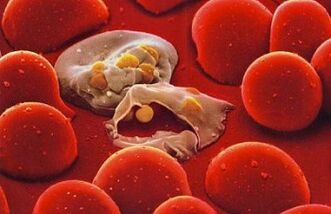
This native of Central Africa roams today in many countries. Plasmodium malaria is transmitted by mosquitoes of the genus Anopheles, which are not very fussy, and the main thing for them is heat and water. Many countries carried out disease prevention: they drained the swamps, destroyed the larvae, and the disease receded there, but this parasite is still raging in the region of Central Africa and South America.
Once in the body, the malaria plasmodium goes through two stages: hepatic and erythrocyte. The first happens within a few hours. Plasmodium attacks liver cells, enters them, begins to multiply, and feeds on the host's nutrients. At this time, a person already feels the first unpleasant symptoms:
- headache;
- nausea;
- lack of appetite.
After a few days, the parasite leaves the liver into the bloodstream and settles in the red blood cells. Live there for a long time. Every 3-4 days it leaves one and enters the other. The exit is accompanied by the release of waste products from the protozoan, therefore, the temperature of the owner rises rapidly and strongly, fever, vomiting and intestinal disorders begin.
Treatment of Plasmodium malaria is difficult because the parasite hides in the host's cells. When the main symptoms of the disease appear, it is necessary to call an ambulance and constantly irrigate the patient before arrival, because the temperature and fever lead to dehydration. A type of plasmodium will be installed in the hospital (there are more than 5) and treatment will be prescribed.
Prevention is simple: surround your place of residence with a mosquito net if there are breeding sites of the Anopheles mosquito in the district, as well as drain the swamps or flood their surface with special means that create a film through which the mosquito larvae cannot. breathe and die. .
Giardia and amoeba dysentery
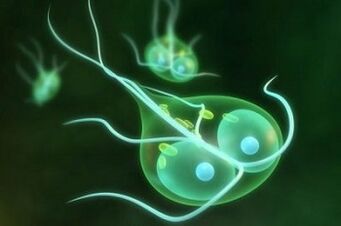
Both parasites live in the human digestive organs and any animal can become their host. They enter the body along with dirty water, unwashed fruits or vegetables. Their favorite places are the liver ducts, the small intestine, and the upper part of the large intestine.
Symptoms will not take long to appear and it is hard not to notice them. The first manifestations are stool disorders. Over time, the temperature rises sharply, severe diarrhea and vomiting begin. Most often, a person dies from dehydration, because the last two symptoms practically do not stop, the patient quickly loses water.
The fight against these parasites consists of drinking plenty of clean boiled water and in special salt packets, preparations that contain a special composition of salts that help retain water in the body. Prevention is also simple: wash the products, control the state of drinking water, because it is she who is the source of reproduction of these parasites.
Flat worms
Parasites in the human body can be both unicellular and multicellular. These are flatworms. The name comes from their shape, because they are really flat, because they breathe with the entire surface of the body, so they try to reduce the volume as much as possible. There are 3 types of flatworms: ciliates, trematodes, and tapeworms. The former are quite harmless, they live on land or in water. But the second two classes are exclusively parasites.
Pacifiers
These are small worms that have suction cups on their mouths and belly. They prefer to live in our body within the duct of the liver and the gallbladder. These helminths have two main life stages: a larva and an adult. The host of the larvae can be aquatic mollusks (liver parasites), fish (cat parasites), but livestock and humans are permanent.
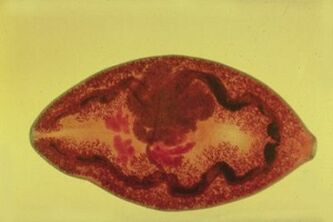
Adults most often settle in the liver area, but can sometimes enter the intestines, lungs, and even the brain. Your accommodation is accompanied by:
- headache;
- Lose weight;
- lack of appetite;
- anemia.
They can only be eliminated with special anthelmintic drugs, which the doctor will prescribe, depending on the type of parasite.
Prevention is simple: don't drink water and try not to swim in stagnant bodies of water, and don't chew blades of grass in the field, as many people like to do, because flatworm larvae can also be in grass.
Headband
Tapeworms are so named because these parasites are of great length (with the exception of the echinococcus), so they really look like a ribbon. They also develop with a change of "place of residence", but most of the time it is the person who is the permanent owner of them.
Bovine and porcine tapeworms attack the small intestine. They are attached with suction cups and hooks, so the stool cannot get them out of thereThey are constantly growing, they can reach a length of 10 meters or more. They can only be expelled from there with special medications that will kill the parasite, the pacifiers will relax, fall off and come out with feces.
One of the most dangerous representatives of tapeworms is the echinococcus. The host of its larvae is man and herbivores, and the adult worm settles in predators. It is the larval stage of the parasite that is dangerous, because it differs in structure from that of the tapeworm.
The echinococcal larva is a sac in which many larvae develop. Such a structure can attack the brain, lungs, intestines, liver. She is dangerous with her unlimited growth, because sooner or later she simply tears the owner's tissues. If the echinococcus has hit the brain or lungs, only one operation can save the patient, but it can also be dangerous.
If tapeworms have settled in our body, then we urgently need to go to the hospital, because they are constantly growing, obstruct the intestines (tapeworms), affect the lungs or brain (echinococci), drink all vital juices and kill their host. . . Prevention consists of checking meat and fish for small white or yellowish larvae. If present, that product should never be eaten!
Round worms
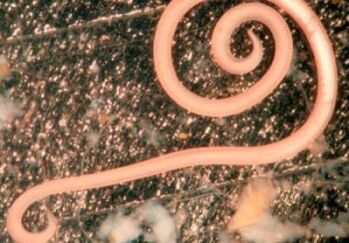
Many have also heard of roundworms, because they poison people's lives as often as flat worms, especially young children suffer from them. The most "famous" representatives are roundworms and pinworms, which inhabit the human intestine. Sometimes they can penetrate other organs: liver, eyes, brain.
Roundworms develop with a change of habitat: the larvae live in the lungs of a person and the adults in the intestines. The name "round" characterizes their cross-sectional shape: they are really round.
These worms do not have holding devices, but they do have muscles that help them resist stool. Sometimes they crawl out of the body (pinworms) and lay eggs in the anus.
It is children who suffer from them, because babies do not know the rules of hygiene, therefore, having combed the place of deposition of the eggs, they can put their fingers in their mouth and become infected again.
Treatment is possible with medications prescribed by a doctor. If the mother of a baby with pinworms is afraid to give him pills, she can cure him without them. To do this, it is necessary at 5-6 in the morning (it is at this time that the female leaves the body and lays eggs around the anus) to clean the inside of the priests with vodka, and then lubricate the treatment site with Cream. for babies so as not to dry out the delicate skin.
Prevention consists in the fact that she must constantly monitor hygiene: wash your hands after touching the ground, do not drink dirty water.
Parasite test
If she has doubts about her own health, she can test the body for parasites. If any of the following symptoms occur, put a plus sign.
- Weight loss is observed without diets or changes in diet.
- The temperature is constantly increasing in the region of 37 to 37. 5 grams.
- There is no appetite or, on the contrary, you constantly want to eat.
- There is often a desire to eat something sweet.
- Increased headaches.
- Flushes of weakness.
- Stool disorders.
- Nausea or vomiting
- Allergic rashes or swelling.
- Pain in the liver and intestines.
- Fainting (if the brain is affected).
- Tingling hands.
- Constant paleness
If there are 1 to 4 advantages, this means that there are no worms, but the person is experiencing constant stress, is ill, or has problems with the digestive tract. If there are 5 to 7 advantages, then there is a suspicion of the presence of parasites, but more than 8 positive responses indicate real problems, so it is urgent to consult a doctor.
Parasites poison the human body, weaken the immune system, prevent them from leading a normal active life, so you need to remember the symptoms of their manifestation and treatment methods, as well as preventive measures, because only then can you protect yourself and your family.


























